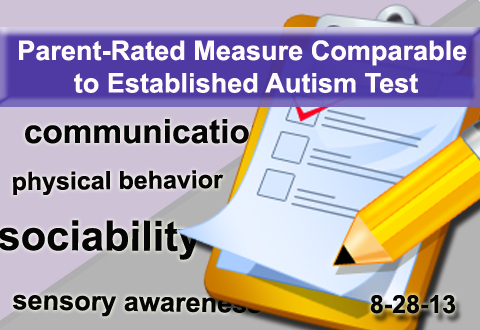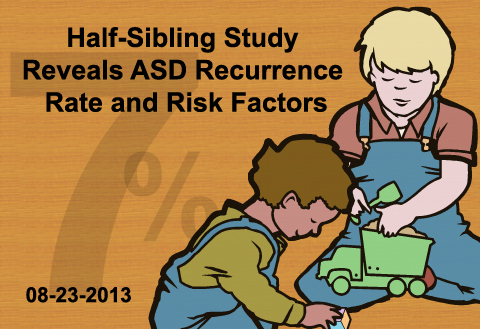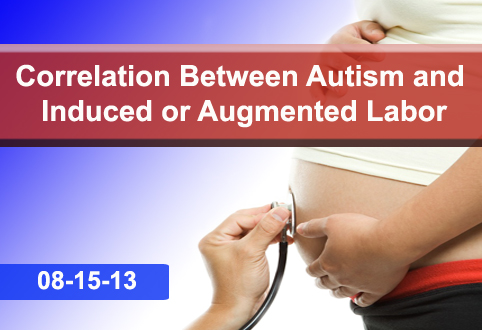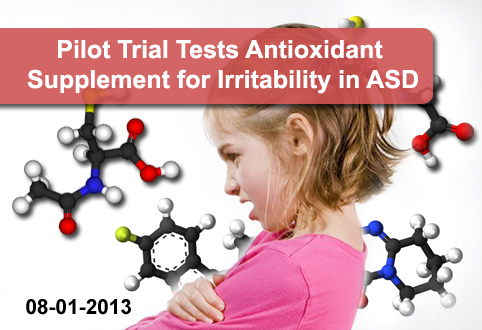Archives
August, 2013
Select a different month in the archive
Parent-Rated Measure Comparable to Established Test
By Chelsea E. Toledo, M.A. on August 28, 2013

Background: Most assessments for autism spectrum disorder (ASD) assess social skills, communicative abilities, and repetitive behaviors. The Autism Treatment Evaluation Checklist (ATEC), administered by parents, tests for ASD’s physical manifestations as well, but has not been extensively evaluated against standard ASD diagnostic tools.
What’s new: On July 3, 2013, a study comparing ATEC to a more established assessment measure was published online in the Journal of Mental Health Research in Intellectual Disabilities. The researchers administered the Child Autism Rating Scale (CARS)—a well-established test for ASD severity—to 56 children aged 2 to 16. Participants’ parents then completed the ATEC survey, which elicited information about the children’s communicative levels, sociability, sensory awareness, and physical behavior. They found a significant association between participants’ scores on the ATEC and CARS measures. However, larger studies are needed to validate this tool.
Why it’s important: This study provides support for the utility of parent-rated ATEC measure to assess ASD. Because the test includes physical criteria, it could provide a more complete picture of children affected by ASD. You can complete the ATEC online at http://www.surveygizmo.com/s3/1318614/Autism-Treatment-Evaluation-Checklist.
Help me understand :
| Source(s) : |
| Tweet |
Half-Sibling Study Reveals ASD Recurrence Risk Factors
By Shana R. Spindler, Ph.D. on August 23, 2013

Background: What is the autism spectrum disorder (ASD) risk for a child who has an older sibling with ASD? Most researchers agree that a mix of genetics and environment affects risk, but they disagree on how much each factor plays a part. This makes risk prediction tricky. Previous reports indicate a wide range in ASD recurrence—when a second child has ASD.
What’s New: In a population-based study, researchers observed ASD recurrence rates in full- and half-siblings. The research team used records for all children, about 1.5 million, born in Denmark between January 1, 1980 and December 31, 2004.
The researchers report an overall recurrence risk of 7 percent. This is significantly higher than the population ASD risk of about 1.2 percent. For half-siblings sharing a father, recurrence rates were similar to the general population risk. In contrast, 2.4 percent of maternal half-siblings had ASD.
Why It’s Important: This study indicates a somewhat lower rate of recurrence than previously reported, a valuable finding for parents. A greater recurrence rate in maternal half-siblings suggests a key role for fetal environment in ASD risk. Also, the smaller recurrence risk in half-siblings, who share fewer genes, confirms a significant genetic contribution.
Help me understand :
| Source(s) : |
| Tweet |
Correlation Between Autism and Induced/Augmented Labor
By Shana R. Spindler, Ph.D. on August 15, 2013

News Brief: A new study has caught the popular media’s attention. University of Michigan and Duke University researchers identified a correlation between autism and induced or augmented labor—the artificial start or enhancement of uterine contractions. The study, however, does not prove that autism is caused by medical interventions during labor. Rather, underlying issues that result in the need for induced or augmented labor may play a role in the development of autism.
While this study provides an interesting lead for future investigations, experts in the field emphasize that the study’s findings should not change current medical practice. For extensive coverage on this issue, please click the “Sources” buttons below.
Help me understand :
| Source(s) : |
| Tweet |
New Tool Provides Potential Screening and Treatment
By Chelsea E. Toledo, M.A. on August 9, 2013

Background: Most assessments for autism spectrum disorder (ASD) are based on a person’s behavior. However, children with ASD are known to display unpredictable patterns of physical movement—a possible target for more personalized autism screening and therapy.
What’s New: On July 24, 2013, the journal Frontiers in Integrative Neuroscience featured a set of studies exploring physical movements as a target for assessing and treating ASD. In the first study, the researchers assessed how 34 individuals with ASD and 44 typically developing control subjects followed cues to point at objects on a screen over a series of trials. They found disruptions in the progress of individuals with ASD as trials ensued. In the second study, the researchers tested the ability of 25 individuals with ASD and 8 control subjects to hold an arm within a desired area. They found that, when provided a reward—the chance to watch an enjoyable video, autistic subject’s movements became more predictable, suggesting that self-discovery tasks can improve anticipatory behavior.
Why it’s important: Fifteen years ago, Teitelbaum et al. showed movement disturbances as integral component of autism that could be clearly detected as early as 4 – 6 month old infants. These two new studies could bring the value of movement analysis in evaluating ASD to the forefront.
Help me understand :
| Source(s) : |
| Tweet |
Antioxidant + Risperidone, Promising Irritability Treatment
By Shana R. Spindler, Ph.D. on August 1, 2013

Background: Glutathione, an antioxidant that protects cells from oxidative stress, is reduced in patients with autism spectrum disorder (ASD). Some researchers propose that an imbalance of antioxidant protection versus oxidative stress plays a role in autism. Clinical trials are underway to assess the therapeutic potential of antioxidant therapy in children and adolescents with ASD.
What’s New: An eight-week study of 40 children with ASD found that children who received the antioxidant N-Acetylcysteine (NAC)—a precursor to glutathione—in addition to risperidone therapy had less irritability than children on risperidone alone. The researchers reported only mild adverse effects from NAC supplements. Side effects included constipation, increased appetite, fatigue, nervousness, and daytime drowsiness. Other social and behavioral aspects of ASD did not improve with the addition of NAC.
Why it’s important: A larger and longer trial is needed to confirm the improved irritability scores. The researchers also do not know if irritability returns upon the discontinuation of NAC supplementation. As a pilot trial, the results of this research offer a promising direction to pursue.
Help me understand :
| Source(s) : |
| Tweet |

